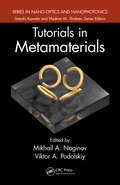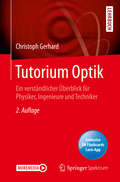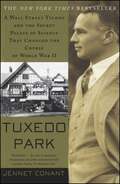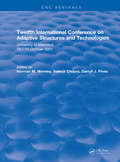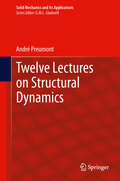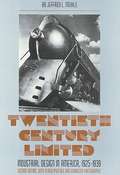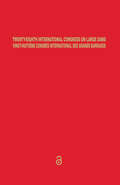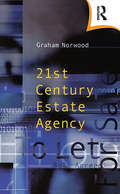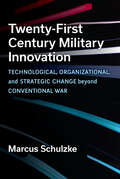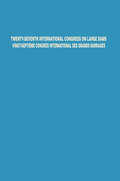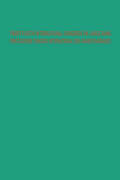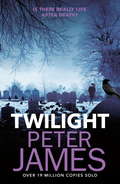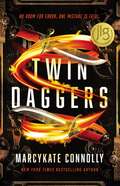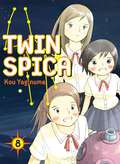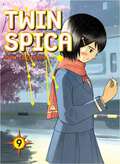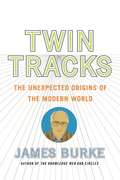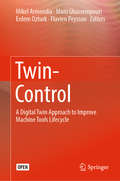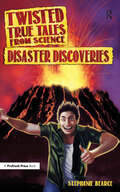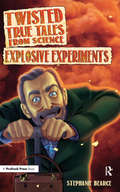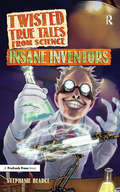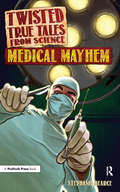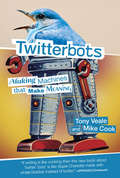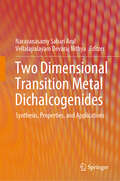- Table View
- List View
Turning Points in Western Technology: A Study of Technology, Science, and History
by D. S. L. CardwellA description of the technological events that changed the course of human history.
Tutorials in Metamaterials (Series in Nano-Optics and Nanophotonics)
by Mikhail A. Noginov Viktor A. PodolskiyFrom science fiction to science laboratoriesDiscover the State of the Art in Photonic MetamaterialsMetamaterials-composite media with unusual optical properties-have revolutionized the landscape of optical science and engineering over the past decades. Metamaterials have transformed science-fiction-like concepts of superresolution imaging and optic
Tutorium Optik: Ein verständlicher Überblick für Physiker, Ingenieure und Techniker
by Christoph GerhardDieses Lehrbuch bietet einen kompakten und einfachen Einstieg in die Optik und unterstützt Studierende der Physik, Technik und anderer angewandter Fächer beim Lernen und Verstehen der Grundlagen und Anwendungen. Der Autor liefert einen anschaulichen Überblick über die essenziellen Teilgebiete der Optik und behandelt die grundlegenden Mechanismen und Prinzipien der Entstehung und Eigenschaften des Lichts, der Lichtausbreitung, Licht-Materie-Wechselwirkungen sowie der optischen Abbildung und Abbildungsfehler. Die Beschreibung von optischen Materialien, Komponenten sowie Laserquellen und Laserstrahlung rundet den Inhalt des Tutoriums ab.Durch zahlreiche Verständnisfragen und Rechenaufgaben unterschiedlicher Schwierigkeitsgrade dient das Tutorium als wertvolle Lernhilfe zur Vertiefung der im Studium und in der Ausbildung vermittelten Lehrinhalte. Die übersichtliche Zusammenfassung der zentralen Erkenntnisse in jedem Teilkapitel und eine Formelsammlung der jeweils wichtigsten mathematisch-physikalischen Zusammenhänge helfen zusätzlich beim Lernen und bei der Prüfungsvorbereitung. Darüber hinaus tragen Beispiele von Alltagsphänomenen, die sich auch in den Übungsaufgaben wiederfinden, zur Veranschaulichung von grundlegenden optischen Gesetzmäßigkeiten und Effekten bei.Im Rahmen dieser überarbeiteten und aktualisierten 2. Auflage erhalten Leser des gedruckten Buches zusätzlich kostenlosen Zugang zu allen Verständnisfragen über die Springer Nature Flashcards-App. Mit Hilfe der digitalen Lernkarten samt ausführlichen Lösungen kann man jederzeit und überall das erlernte Wissen überprüfen.
Tuxedo Park: A Wall Street Tycoon and the Secret Palace of Science That Changed the Course of World War II (Biography Ser.)
by Jennet ConantA New York Times bestseller! The untold story of the eccentric Wall Street tycoon and the circle of scientific geniuses who helped build the atomic bomb and defeat the Nazis—changing the course of history.Legendary financier, philanthropist, and society figure Alfred Lee Loomis gathered the most visionary scientific minds of the twentieth century—Albert Einstein, Werner Heisenberg, Niels Bohr, Enrico Fermi, and others—at his state-of-the-art laboratory in Tuxedo Park, New York, in the late 1930s. He established a top-secret defense laboratory at MIT and personally bankrolled pioneering research into new, high-powered radar detection systems that helped defeat the German Air Force and U-boats. With Ernest Lawrence, the Nobel Prize–winning physicist, he pushed Franklin Delano Roosevelt to fund research in nuclear fission, which led to the development of the atomic bomb. Jennet Conant, the granddaughter of James Bryant Conant, one of the leading scientific advisers of World War II, enjoyed unprecedented access to Loomis’ papers, as well as to people intimately involved in his life and work. She pierces through Loomis’ obsessive secrecy and illuminates his role in assuring the Allied victory.
Twelfth International Conference on Adaptive Structures and Technologies (CRC Press Revivals)
by Inderjit Chopra Norman M. Wereley Darryll J. PinesFirst Published in 2017. Routledge is an imprint of Taylor & Francis, an Informa company.
Twelve Lectures on Structural Dynamics
by André PreumontThis text addresses the modeling of vibrating systems with the perspective of finding the model of minimum complexity which accounts for the physics of the phenomena at play. The first half of the book (Ch.1-6) deals with the dynamics of discrete and continuous mechanical systems; the classical approach emphasizes the use of Lagrange's equations. The second half of the book (Ch.7-12) deals with more advanced topics, rarely encountered in the existing literature: seismic excitation, random vibration (including fatigue), rotor dynamics, vibration isolation and dynamic vibration absorbers; the final chapter is an introduction to active control of vibrations. The first part of this text may be used as a one semester course for 3rd year students in Mechanical, Aerospace or Civil Engineering. The second part of the text is intended for graduate classes. A set of problems is provided at the end of every chapter. The author has a 35 years experience in various aspects of Structural dynamics, both in industry (nuclear and aerospace) and in academia; he was one of the pioneers in the field of active structures. He is the author of several books on random vibration, active structures and structural control.
Twentieth Century Limited: Industrial Design in America, 1925-1939, Second Edition
by Meikle Jeffrey L.In the late 1920's "streamlined" became the term businessmen used to describe new models that were easier to produce as well as those that met with less sales resistance than older products. Illustrating this concept with streamlined objects from soup cans to the Chrysler building, Jeffrey Meikle's classic book, Twentieth Century Limited, celebrates the birth of the industrial design profession from 1925-1939. This second edition includes a new preface and improved photographic reproduction. Commercial artists who answered the call of business -- Walter Dorwin Teague, Norman Bel Geddes, Henry Dreyfuss, and Raymond Loewy the best known among them -- were pioneers who envisioned a coherent machine-age environment in which life would be clean, efficient, and harmonious. Working with new materials -- chrome, stainless steel, Bakelite plastic -- they created a streamlined expressionist style which reflected the desire of the Depression-era public for a frictionless, static society. Appliances such as Loewy's Coldspot refrigerator "set a new standard" (according to the advertisements), and its usefulness extended to the way it improved the middle-class consumer's taste for sleek new products. Profusely illustrated with 150 photographs, Twentieth Century Limited pays tribute to the industrial designers and the way they transformed American culture; a generation after its initial publication, this book remains the best introduction to the subject. The new edition will fascinate anyone interested in art, architecture, technology, and American culture of the 1930's.
Twenty-Eighth International Congress on Large Dams/Vingt-Huitième Congrès International des Grands Barrages
by Icold CigbThe International Commission on Large Dams (ICOLD) held its 28th International Congress in Chengdu, China (16 May – 23 May 2025). The proceedings of the congress focussed on four main questions (Questions108-111): 1. Dams and reservoirs for climate change adaptation; 2. Dams and levees fit for the future; 3. Safety of dams and levees facing extreme hydrological events, and 4. Earthquake performance and safety of dams. The book thoroughly discusses these questions and is indispensable for academics, engineers and professionals involved or interested in engineering, hydraulic engineering, and related disciplines.La Commission Internationale des Grands Barrages (CIGB) a tenu son 28e Congrès International à Chengdu, Chine (16 mai - 23 mai 2025). Les actes du congrès portent sur quatre questions (Questions 108-111) principales : 1. Barrages et réservoirs: adaptation aux changements climatiques; 2. Des barrages et des digues prêts pour l’avenir; 3. Sécurité des barrages et des digues lors des évènements météorologiques extrêmes, et 4. Performance sismique et sécurité des barrages. Le livre traite en profondeur de ces questions et est indispensable pour les universitaires, les ingénieurs et les professionnels impliqués ou intéressés par l'ingénierie, l'ingénierie hydraulique et les disciplines connexes.
Twenty-First Century Estate Agency
by Graham NorwoodThis book is a must have for those estate agents who want to work more effectively in order to grow their business and profits. With 12,000 separately owned estate agencies in the UK this book illustrates how new technology and working practices can revolutionise the industry. Technology can help to improve the competitiveness and sometimes-tarnished image of estate agents in the eyes of the general public. The book contains case studies from international markets and shows how competitive the industry is and how each competitor needs to adopt new approaches to outwit rivals – and to reassure an increasingly sceptical public that agents are worth using, add value and earn their commission.
Twenty-First Century Military Innovation: Technological, Organizational, and Strategic Change beyond Conventional War
by Marcus SchulzkeContemporary war is as much a quest for decisive technological, organizational, and doctrinal superiority before the fighting starts as it is an effort to destroy enemy militaries during battle. Armed forces that are not actively fighting are instead actively reengineering themselves for success in the next fight and imagining what that next fight may look like. Twenty-First Century Military Innovation outlines the most theoretically important themes in contemporary warfare, especially as these appear in distinctive innovations that signal changes in states’ warfighting capacities and their political goals. Marcus Schulzke examines eight case studies that illustrate the overall direction of military innovation and important underlying themes. He devotes three chapters to new weapons technologies (drones, cyberweapons, and nonlethal weapons), two chapters to changes in the composition of state military forces (private military contractors and special operations forces), and three chapters to strategic and tactical changes (targeted killing, population-centric counterinsurgency, and degradation). Each case study includes an accessible introduction to the topic area, an overview of the ongoing scholarly debates surrounding that topic, and the most important theoretical implications. An engaging overview of the themes that emerge with military innovation, this book will also attract readers interested in particular topic areas.
Twenty-Seventh International Congress on Large Dams Vingt-Septième Congrès International des Grands Barrages
by Icold CigbThe International Committee on Large Dams (ICOLD) held its 27th International Congress in Marseille, France (12-19 November 2021). The proceedings of the congress focus on four main questions: 1. Reservoir sedimentation and sustainable development; 2. Safety and risk analysis; 3. Geology and dams, and 4. Small dams and levees. The book thoroughly discusses these questions and is indispensable for academics, engineers and professionals involved or interested in engineering, hydraulic engineering and related disciplines.
Twenty-Sixth International Congress on Large Dams / Vingt-Sixième Congrès International des Grands Barrages: 4th - 6th July 2018, Vienna, Austria
by International Commission On Large DamsThe International Committee on Large Dams (ICOLD) held its 26th International Congress in Vienna, Austria (1-7 July 2018). The proceedings of the congress focus on four main questions: 1. Reservoir sedimentation and sustainable development; 2. Safety and risk analysis; 3. Geology and dams, and 4. Small dams and levees. The book thoroughly discusses these questions and is indispensable for academics, engineers and professionals involved or interested in engineering, hydraulic engineering and related disciplines.
Twilight
by Peter JamesThree muffled thuds ring from the partially filled grave of the newly wed girl. Only the verger hears them and he dismisses the noise as his imagination. But over the next few days others also hear faint sounds.An exhumation order is granted. Reporter Kate Hemingway sneaks into the small suburban churchyard when the coffin is opened, and the scene she witnesses is so horrific she can never forget it. As she starts work on the story, Kate finds herself caught up in a sinister and macabre cover-up.At the centre is a respected anaesthetist who has a secret obsession. He believes people can exist outside their bodies and that if he can prove it he will provide the answer to the question that has haunted mankind through the ages: is there life after death? Nothing - and no one - is going to stand in the way of his driving ambition . . .'Peter James is one of the best crime writers in the business.' Karin Slaughter'Well-researched, chillingly executed and eminently readable.' Sunday TimesRead more from the multi-million copy bestselling author of the Roy Grace novels:Possession DreamerSweet Heart Twilight Prophecy Host Alchemist Denial The Truth Faith * Each Peter James novel can be read as a standalone*
Twilight
by Peter JamesThree muffled thuds ring from the partially filled grave of the newly wed girl. Only the verger hears them and he dismisses the noise as his imagination. But over the next few days others also hear faint sounds.An exhumation order is granted. Reporter Kate Hemingway sneaks into the small suburban churchyard when the coffin is opened, and the scene she witnesses is so horrific she can never forget it. As she starts work on the story, Kate finds herself caught up in a sinister and macabre cover-up.At the centre is a respected anaesthetist who has a secret obsession. He believes people can exist outside their bodies and that if he can prove it he will provide the answer to the question that has haunted mankind through the ages: is there life after death? Nothing - and no one - is going to stand in the way of his driving ambition . . .'Peter James is one of the best crime writers in the business.' Karin Slaughter'Well-researched, chillingly executed and eminently readable.' Sunday TimesRead more from the multi-million copy bestselling author of the Roy Grace novels:Possession DreamerSweet Heart Twilight Prophecy Host Alchemist Denial The Truth Faith * Each Peter James novel can be read as a standalone*
Twin Daggers
by MarcyKate ConnollyAissa&’s life is a web of carefully constructed lies. She and her twin sister, Zandria, are Magi spies, a magical people most believe to be extinct. And they&’re on a mission for revenge. This action and adventure spy thriller—a fantasy spin on &“Romeo and Juliet&” from New York Times bestselling author MarcyKate Connolly—is perfect for fans of Marissa Meyer and Elly Blake and is about to become your new obsession!By day, Aissa and Zandra play the role of normal young Technocrats eager to fulfill the duties of their new apprenticeships. By night, they plot their revenge to retake their city from the Technocrats. But then Aissa is given a new mission: find and kidnap the heir to the Technocrat throne, who is rumored to be one of the Heartless—a person born without a working heart who survives via a mechanical replacement—and has been hidden since birth.Aissa is more likely to be caught than to be successful, but she's never been one to turn down an assignment, even if the hunt is complicated by a kind Technocrat researcher who is determined to find a cure for the Heartless. But when Zandria is captured by the Technocrats, Aissa will do anything to get her sister back. Even if it means abandoning all other loyalties and missions … and risking everything by trusting her sworn enemies.
Twin Spica 8 (Twin Spica #8)
by Kou YaginumaThe astronaut selection test is around the corner and one member of the TSS's first class is quietly preparing for this challenge. This student has plenty to prove, but to do so without the aide of family or friends might be even more difficult. The exam will send one of these friends to America. Will it be worth the heartache?
Twin Spica 9 (Twin Spica #9)
by Kou YaginumaIn the ninth volume of Twin Spica, Asumi and her classmates are getting closer and closer towards graduation, and changes in store for this group of friends. There will be good-byes to be said and that might end up causing some tension within this group. Some of that friction might be spurred on from outside of the Tokyo Space School as the media has caught on to the identities of at least one prime candidate.
Twin Tracks: The Unexpected Origins of the Modern World
by James BurkeTwin Tracks is a landmark book of real-world stories that investigates the nature of change and divines as never before the unlikely origins of many aspects of contemporary life. In each of the work's twenty-five narratives, we discover how the different outcomes of an important historical event in the past often come together again in the future.<P><P> Each chapter starts with an event -- such as the U.S. attack on Tripoli in 1804 -- that generates two divergent series of consequences. After tracking each pathway as it ranges far and wide through time and space, Burke shows how the paths finally and unexpectedly converge in the modern world.<P> Twin Tracks pinpoints the myriad ways the future is shaped, whether by love, war, accident, genius, or discovery. For instance, in "The Marriage of Figaro to Stealth Fighter," Burke's twin tracks start with the composer of the opera and the French spy from whose play he stole the plot. The tracks then encompass, among other things, freemasonry, the War of Independence, Captain Cook, jellyfish, Jane Austen, and audio tape. Ultimately, the convergence of the two Figaro tracks sets the stage for the development of Gulf War Stealth aircraft.<P> Wonderfully accessible and lucidly written, Twin Tracks offers an amusing and instructive new view of the past and the future.
Twin-Control: A Digital Twin Approach to Improve Machine Tools Lifecycle
by Mikel Armendia Mani Ghassempouri Erdem Ozturk Flavien PeyssonThis open access book summarizes the results of the European research project “Twin-model based virtual manufacturing for machine tool-process simulation and control” (Twin-Control). The first part reviews the applications of ICTs in machine tools and manufacturing, from a scientific and industrial point of view, and introduces the Twin-Control approach, while Part 2 discusses the development of a digital twin of machine tools. The third part addresses the monitoring and data management infrastructure of machines and manufacturing processes and numerous applications of energy monitoring. Part 4 then highlights various features developed in the project by combining the developments covered in Parts 3 and 4 to control the manufacturing processes applying the so-called CPSs. Lastly, Part 5 presents a complete validation of Twin-Control features in two key industrial sectors: aerospace and automotive. The book offers a representative overview of the latest trends in the manufacturing industry, with a focus on machine tools.
Twisted True Tales From Science: Disaster Discoveries
by Stephanie BearceLondon was once covered in a fog so polluted that it killed 12,000 people. The Aleppo earthquake killed 230,000 people, and a wall of water mysteriously wiped out the whole town of Burnham-on-Sea. All of these were catastrophic disasters, but they led to important discoveries in science. Learn about how the earth turned to liquid in New Zealand and what happens when a tsunami meets a nuclear reactor. These stories may sound twisted and strange, but they are all true tales from science!Ages 9-12
Twisted True Tales From Science: Explosive Experiments
by Stephanie BearceTwo thousand years ago, Chinese scientists were looking for a medicine that would make them live forever. Instead, they blew up their lab and discovered gunpowder. Alfred Nobel blew up his laboratory twice before he discovered the formula for dynamite. Learn about the Apollo 13 and Challenger explosions and the strange space explosions caused by top secret Starfish Prime. These stories may sound twisted, but they're all true tales from science!Ages 9-12
Twisted True Tales From Science: Insane Inventors
by Stephanie BearceNikola Tesla was crazy smart. He invented the idea for cell phones in 1893, discovered alternating current, and invented a death ray gun. Of course, he also talked to pigeons, ate only boiled food, and was scared of women who wore jewelry. He was an insane inventor. So was Henry Cavendish, who discovered hydrogen, calculated the density of the Earth, and was so scared of people that he had to write notes to communicate. Sir Isaac Newton discovered the laws of gravity, believed in magic, and thought he could make a potion to create gold. These stories may sound twisted, but they're all true tales from science!Ages 9-12
Twisted True Tales From Science: Medical Mayhem
by Stephanie BearceGround-up mummy bones, leeches sucking human blood, and a breakfast of dried mouse paste. It sounds like a horror movie, but those were actual medicines prescribed by early doctors. Medical students studied anatomy on bodies stolen from graves and had to operate on people while they were awake. Learn about the medicines that came from poison and doctors who experimented on themselves and their families. It's a twisted tale of medical mayhem, but it's all true!Ages 9-12
Twitterbots: Making Machines that Make Meaning
by Mike Cook Tony VealeThe world of Twitterbots, from botdom's greatest hits to bot construction to the place of the bot in the social media universe. Twitter offers a unique medium for creativity and curiosity for humans and machines. The tweets of Twitterbots, autonomous software systems that send messages of their own composition into the Twittersphere, mingle with the tweets of human creators; the next person to follow you on Twitter or to “like” your tweets may not a person at all. The next generator of content that you follow on Twitter may also be a bot. This book examines the world of Twitterbots, from botdom's greatest hits to the hows and whys of bot-building to the place of bots in the social media landscape. In Twitterbots, Tony Veale and Mike Cook examine not only the technical challenges of bending the affordances of Twitter to the implementation of your own Twitterbots but also the greater knowledge-engineering challenge of building bots that can craft witty, provocative, and concise outputs of their own. Veale and Cook offer a guided tour of some of Twitter's most notable bots, from the deadpan @big_ben_clock, which tweets a series of BONGs every hour to mark the time, to the delightful @pentametron, which finds and pairs tweets that can be read in iambic pentameter, to the disaster of Microsoft's @TayAndYou (which “learned” conspiracy theories, racism, and extreme politics from other tweets). They explain how to navigate Twitter's software interfaces to program your own Twitterbots in Java, keeping the technical details to a minimum and focusing on the creative implications of bots and their generative worlds. Every Twitterbot, they argue, is a thought experiment given digital form; each embodies a hypothesis about the nature of meaning making and creativity that encourages its followers to become willing test subjects and eager consumers of automated creation.Some bots are as malevolent as their authors. Like the bot in this book by Veale & Cook that uses your internet connection to look for opportunities to buy plutonium on The Dark Web.”—@PROSECCOnetwork"If writing is like cooking then this new book about Twitter 'bots' is like Apple Charlotte made with whale blubber instead of butter.”—@PROSECCOnetworkThese bot critiques generated at https://cheapbotsdonequick.com/source/PROSECCOnetwork
Two Dimensional Transition Metal Dichalcogenides: Synthesis, Properties, and Applications
by Narayanasamy Sabari Arul Vellalapalayam Devaraj NithyaThis book presents advanced synthesis techniques adopted to fabricate two-dimensional (2D) transition metal dichalcogenides (TMDs) materials with its enhanced properties towards their utilization in various applications such as, energy storage devices, photovoltaics, electrocatalysis, electronic devices, photocatalysts, sensing and biomedical applications. It provides detailed coverage on everything from the synthesis and properties to the applications and future prospects of research in 2D TMD nanomaterials.

